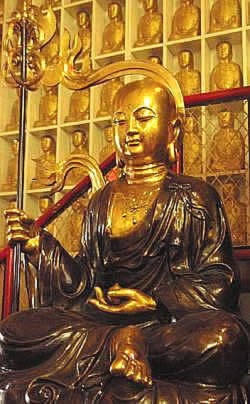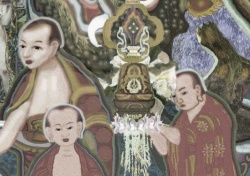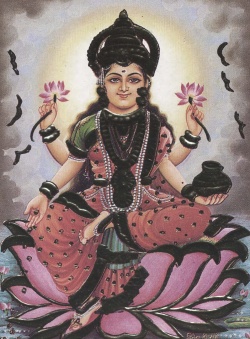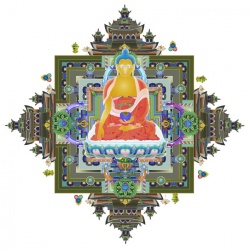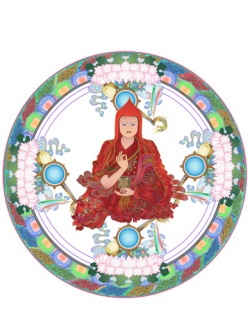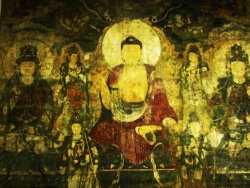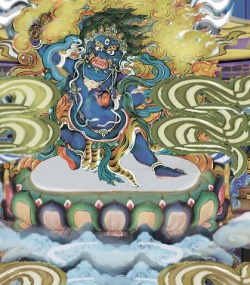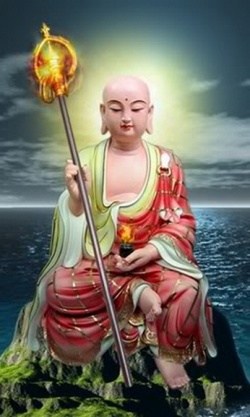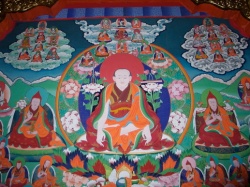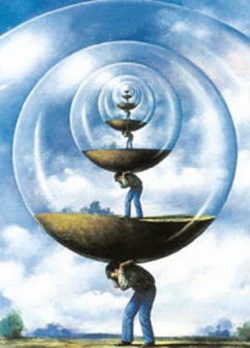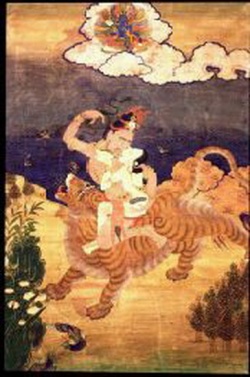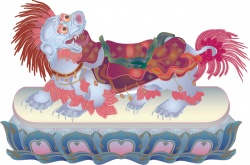Totemic Beliefs in the Buddhist Tantras
By Alex Wayman
The investigation of totemic beliefs in connection with the Buddhist Tantras has implications for the origins of the practices depicted in this literature. Before expanding this idea, a few general remarks are in order.
The subject of Tantra has elicited increasing attention from students of Indian religious history, but specialists in this field know the difficulties of understanding this literature. It is vast, associated with obscure cults whose adepts take vows not to divulge the secrets to non-initiates, and its texts often have linguistic problems. A number of texts of Hindu Tantra have been edited; and some bulky studies on these works have appeared in Western languages. The Buddhist Tantras also have been given special treatment by some qualified scholars; and a growing, even if still modest, number of edited texts, translations, and studies are now available, properly speaking if one has access to a good university library or its equal. The most extensive body of Buddhist Tantras is the scriptural This paper is an expansion of a talk with the same title delivered at the annual spring meeting (1960) of the Western Branch of the American Oriental Society. Tibetan texts mentioned are for the most part in the East Asiatic Library, University of California, Berkeley.
canon of translated Tantra in the Tibetan Kanjur and the translated commentarial literature of Tantra in the Tibetan Tanjur. Many of these works are extant in manuscript form in the original Indic languages, but relatively few of such manuscripts have been edited in modern format. A considerable number of Buddhist Tantras are available in Chinese translations and so also in Japanese versions based on the latter. There are, moreover, a great number of native Tibetan commentaries on the Tantras, as well as a smaller body of native Chinese and Japanese exegetical treatises.
A recent work by Debiprasad Chattopadhyaya, Lokayata. A Study in Ancient Indian Materialism (New Delhi, 1959), discourses extensively on totemism in ancient India, with findings that dovetail my own researches in the Buddhist Tantras. This author's enthusiasm for the thesis which inspired his book, as suggested by its title, has the advantage of bringing together many interesting materials, and it has the disadvantage of forcing certain topics to conform to the thesis. He devoted a large chapter to Tantra, but this presentation is of less value for my purposes than his discussion of totemism proper. This is not to say that I disagree with his viewpoint as embodied in a quotation (p. 329) from S. B. Dasgupta's Obscure Religious Cults: Tantrism is neither Buddhist nor Hindu in origin: it seems to be a religious undercurrento, riginallyi ndependento f any abstrusem etaphysicals peculation, flowingo n froma n obscurep oint of time in the religioush istoryo f India.
Rather, my contention is that one cannot expose a common undercurrent simply by stripping Hinduism from the Hindu Tantras and Buddhism from the Buddhist Tantras. There are certain teachings of these two bodies of Tantras that are at variance with one another, quite apart from the overlay of typically Hindu or Buddhist doctrine. For instance, while both systems have a group of "centers" (cakras) in the body referred to as lotuses each with a given number of petals, there is much disagreement between the Hindu Tantras, on the one hand, and the Buddhist Tantras, on the other, in the description of these "centers." However, those who are motivated to find the two systems basically identical content themselves with such primitive comparisons as, for example (p. 326), observing that certain deities of the Hindu Tantras are equivalent to certain ones of the Buddhist Tantras.
In short, my conclusions about totemic beliefs in the Buddhist Tantras imply nothing concerning Hindu Tantras. Indeed, hitherto I have not noticed during my admittedly inadequate researches in the Hindu Tantric literature the main features to be set forth in this essay that are drawn from the Buddhist Tantras.
Another point to be settled is the use of the expression "totemic beliefs. Here I mean that the classification of the animate and inanimate objects of the world under one or other of the families of Buddhas (usually five in number) constitutes totemic beliefs in the Buddhist Tantras. This is not to maintain that these Tantric families have all the features which anthropologists attribute to totemism as it is found in various "primitive" tribes. For example, the feature of exogamy is not generally adhered to by the deities of these Tantric families. A male deity may have as consort a goddess which is actually his own creation through his "seal" (mudra). Notably, one of the most celebrated of our supposedly human ancestors, Adam by name, had a comparable consort.
This very example-where the story of Adam and Eve comes to mind in connection with the fact of a male deity marrying his own female emanation-illustrates our procedure: analogy. This way of thinking, if properly conducted, serves to carry the scientific formulations of one field of data to another field and to specialize accordingly the viewpoint toward the latter. If it be admitted that a vast subject such as Tantra can be treated only in limited aspects through the agency of a good-sized book-still less by an essay of the present scope-it should also be admitted that a methodical limitation is preferable to a haphazard one. The method herein adopted to provide the limitation is that of analogy. But the method of analogy has its pitfalls, especially if one does not seek systematic resemblances. The foregoing defines the writer's task.
THE TOTEM
We learn from Durkheim's treatment of the native Australian tribes that the totem is the collective designation of the clan. It is a name first of all and then an emblem. It is the typical sacred thing. The objects which serve as totems belong preponderately to the animal or the vegetable kingdom; inanimate things are sometimes, but more rarely, employed. All things, animate and inanimate, are classified under the various clans of a tribe. "Men regard the things in their clan as their relatives or associates; they call them their friends and think that they are made out of the same flesh as themselves."2 The five Buddhas under which disparate objects are usually classified have the names Vairocana, Aksobhya, Amitabha, Ratnasambhava, and Amoghasiddhi. Their families or clans (kula) are called, respectively, (1) Cakra (wheel) or Tathagata (thus-come), (2) Vajra 2 fmile Durkheim, The Elementary Forms of the Religious Life, trans. J. W. Swain (Glencoe, Ill.: Free Press, 1954), pp. 102, 103, 110, 119, 142, 149.
Totemic Beliefs in the Buddhist Tantras
(diamond or thunderbolt), (3) Padma (lotus), (4) Ratna (jewel), and (5) Khadga (sword), Karma (ritual action), or Samaya (pledge). Each of the five Tantric clans has a name which is an emblem and refers to a concrete entity, wheel, etc., that has a sacred character, although it is true that the first and fifth of these clans are called more frequently the Tathagata and Karma clans, respectively. Especially the first three emblems, that is, cakra, padma, and vajra, have rich and ancient mythological associations in India. The identification of Vairocana, a name of the sun, with the Cakra Clan shows that the word cakra (wheel) maintains its primary value as a symbol of the sun, and the alternate name Tathagata (thus-come, or "one who has come the same way") confirms this interpretation.3 The lotus "means the source of life and the power to continue to give life"; it also "stands for purity, as it rises from mud but remains clean."4
The vajra, as thunderbolt or diamond, stands for the power that overcomes obstacles; in the Rigveda Indra overcomes the personified obstacle Vrtra with this vajra; in the Buddhist Tantras a like function is credited to Vajrapani ("thunderbolt-handed"), the Bodhisattva master of the Vajra Clan.
It is of interest that the pentad can be reduced to an earlier triad by absorption of Amoghasiddhi into Vairocana, and Ratnasambhava into Amitabha.6 In the latter case, the Ratna (jewel) Clan is absorbed into the Padma (lotus) Clan, and we recall the celebrated mantra, Om mani padme hum ("Om, the Jewel [magi] in the Lotus, Hum"), suggesting the creative act and the intrinsic purity of the mind. In the former case, the significance of the absorption is seen better through the names Tathagata (thus-come or thus-comprehended) and Karma (ritual action), pointing to the unity action-intuition or practical wisdom.
The increase to seven clans in the Mother Tantra of the Anuttarayoga- tantra6 division involves a sixth Buddha, Vajrasattva, and a seventh, Heruka. These, in turn, may be taken together as one clan 3 Cf. Paul Horsch, "The Wheel: An Indian Pattern of World Interpretation," Liebenthal Festschrift ("Sino-Indian Studies," No. 5, 3-4 [[[Wikipedia:Santiniketan|Santiniketan]], 1957]), pp. 62-79.
4Wing-tsit Chan "The Lotus Sutra " mimeographed text, presented at Conference on Oriental Classics in General Education, Columbia University, September 12-13, 1958.
5 D. L. Snellgrove, The Hevajra Tantra ("London Oriental Series," No. 6 [[[Wikipedia:London|London]], 1959]), I, 61, n. 2.
6 The standard division of Buddhist Tantric literature as arranged in the Tantra section (rgyud hbum) of the Tibetan Kanjur is into the Kriya Tantra, Carya Tantra, Yoga Tantra, and Anuttara-yoga Tantra. The Anuttara-yoga Tantra in turn is divided into "Father Tantras" and "Mother Tantras."
in the Anuttara-yoga-tantra by regarding Vajrasattva as the causal Vajradhara and Heruka as the fruitional Vajradhara. This unified clan is headed by the Buddha Vajradhara. It will not be necessary for the purposes of the present essay to consider further these sixth and seventh clans.
The division of Tantras called "Yoga-tantra" has the pentad, but its correspondence system is generally based on four clans. An important commentary following the school of Buddhaguhya states: He said: "That one of those clans which arises from the 'heart' (hrdaya) of the Tathagata is the Tathagata clan. The one arising from the Vajra is the Vajra clan. The one arising from the Padma is the Padma clan. The one arising from the Ratna is the Ratna clan." Thus he taught diverse clans.7 This passage shows the relationship of the various members of a particular clan: they have the same origin or ancestor.
PERSONS IN THE CLANS
The commentary previously quoted classifies persons in those clans in terms of the major defect to be eliminated. This emphasis on the negative cult is consistent with the oldest forms of Buddhism which expressed the religious goal in negative terms. Thus Nirvana itself is understood to mean the "blowing out" of the passions, the "release" from the phenomenal world. The commentary states: In regard to the series, "Vajra, Padma, Ratna, . . Clans (kula)," that is the way the Bhagavat has taught the jewel-like Bodhisattvas; and since the sentient beings to be trained are of four kinds according as they possess lust (raga),h atred (dveqa)d, elusion( moha),o r pride (mana),h is teachingsa re of four kinds as antidotes.8
The work then relates explicitly each of the four clans to the particular candidates for training. The correspondence is as listed.
Clan Candidate
Tathagata. ............... Preponderancoe f lust Vajra. ................... Preponderancoe f hatred Padma..... ........ Preponderancoe f delusion Ratna. .................. Preponderancoe f pride The first three qualities, lust, hatred, and delusion, are ancient Buddhist categories referred to as the fundamental corruptions (mulakleta) and as the "three poisons." The addition of pride as the fourth is consistent with Asafiga's Srdvakabhumi, where the classification of 7 This work by Padmavajra, called Tantrdrthdvatdravyakhyanisa ,a commentary of Buddhaguhya's Tantrdrthdvatdra. The citation is part of a longer passage on this subject located in the Derge Tanjur (Tohoku Catalog No. 2502), Rgyud, hi, 113b-7 ff.
Totemic Beliefs in the Buddhist Tantras
persons who have definite meditative objects by reason of conduct lists preponderance of lust, hatred, or delusion, as the first three and adds pride and discursive thought (vitarka) as the fourth and fifth.9 However, Anandagarbha's school of the Yoga-tantra has preponderance of avarice (mdtsarya) as the fourth, rather than pride.10 This divergence between the two schools of the Yoga-tantra in the matter of the fourth clan, while the two maintain consistency on this point of the first three clans, further indicates the primacy of these three clans, which are now related to the old Buddhist terminology of "three poisons."
In a different class of Tantric literature, the correspondence of clans to persons may vary considerably. We might therefore introduce the terminology of "tribe," especially to differentiate the set of clans in each of the four principal divisions of Tantra. For example, the Hevajra-tantra is now accessible, as edited by Snellgrove, to illustrate such a tribe of clans in the Anuttara-yogatantra. Here we find the five Buddhas corresponding to five types of candidates as shown in the accompanying listing.
Vairocana.. ..................... Delusion
Ak4obhya.. ..................... Hatred
Amitabha.. ..................... Lust
Ratnasambhava.. ............... Slander( paisunya)
Amoghasiddh..i. ................ Jealousy( irsya)
Again we see the "three poisons" made to correspond to the primary three Buddhas, but only Akeobhya's Vajra Clan is consistent with the Yoga-tantra in the correspondence to hatred. On the other hand, Vairocana's Tathagata or Cakra Clan and Amitabha's Padma Clan have interchanged the correspondences, now to delusion and lust, respectively. This difference of correspondences amounts to an altered interpretation of all three totems, Cakra, Padma, and Vajra. In the Anuttara-yoga-tantra, as contrasted with the other three Tantra divisions, the expressions Vajra and Padma are employed in sexual symbolism and refer to "male" and "female," respectively. In this way of thinking, hatred is "male" and lust is "female." A natural question is: Which clan would include the person who does not exhibit any of those basic faults in a preponderant manner? The Yoga-tantra holds that the person having "the three poisons in equal parts" evokes all five Buddhas." This idea is clear from non- 9 Alex Wayman, Analysis of the Srdvakabhumi Manuscript, in press in the series "University of California Publications in Classical Philology." 10 F. D. Lessing and Alex Wayman (trans.), "Mkhas grub rje's General Summary of the Tantras" (typescript MS).
n Ibid.
Tantric Buddhism, where the person with "conduct in equal parts" (samabhdgacarita), since none of the psychological poisons are strong enough to predominate in him, adopts according to his pleasure any one of the five meditative objects set forth for the five kinds of predominant conduct.12
The Tantric author Indrabhuti, commenting on an important Tantra lying in the domain of the Mother Tantra of the Anuttara-yogatantra, writes: "Furthermore, the expression 'complete universal seal (mudrd)' means that all the sentient beings of the three realms are sealed by right knowledge."'3 Here, "the three realms" are the realm of desire, realm of form, and formless realm-standard terminology of non-Tantric Buddhism. Right knowledge" presumably refers to the five kinds of knowledge which are respectively essential to the five Buddhas, as portrayed in the next section.
CLASSIFICATION IN CLANS
Given a Tantric tribe with its clans, the Tantric school involved then divides up among these clans the universe of things that matter. In the Anuttara-yoga-tantra, the five Buddhas with male appearance are said to be the five personality aggregates, the five kinds of knowledge, and the five ambrosias. The five Buddhas, having assumed female appearance, are the purity of the five elements and of the five outer sensory domains. Many other correspondences are presented in the Tantric works, not always consistent. The Anuttara-yoga-tantra correspondence with candidates was shown in the preceding section. Table 1, including other classified entities, is entirely drawn from texts, but a selection was made to exhibit those elements which are most suggestive for Indian religious psychology in the attire of the Buddhist Tantras.14
12 Alex Wayman (trans.), "The Meditative Section of the Lam rim chen mo" (typescript MS). The doctrine is taken from Asanga's Srdvakabhami. 13 This is his commentary, called Smrtisamdarsanaloka, on the "Mother" or yogini Tantra, entitled Sri Samputatilaka. The passage is from the Derge Tanjur, Rgyud, Ca, 153b-3: "yan na kun du sna tshogs phyag rgya ni khams gsum gyi serns can thams cad yan dag pahi ye ses kyis rgyas btab pah. o." 14 The Table results from my readings in this literature over a number of years.
Many such textual correspondences are presented by way of identification with the five winds, prdna, apdna, udana, samdna, and vydna, which in the given order are the natures of the five Buddhas, Aksobhya, and so on, of the Table. This is the order in which they are explained in the collected works. Klofi rdol bla ma Sec. Ga (Peking ed.), 29a-4 ff., identified with the Buddhas, elements, and bodily locations. The correspondence of Buddhas to knowledges is that given in the Advayavajra-Samgraha ("Gaekwad Oriental Series," Vol. XC), p. 36; this is consistent with F. D. Lessing and Alex Wayman (trans.), op. cit. I gave a reference for the Buddha-skandha equation in my article "Contributions Regarding the Thirty-two Characteristics of the Great Person," Liebenthal Festschrift, p. 245,
Clan Name
Vajra (thunderbolt or
diamond)..........
Ratna (jewel)........
Padma (lotus)........
Khadga (sword), Karma
(ritual action), or
Samaya (pledge)....
Cakra (wheel), or Tathagata
(thus-come)
Buddha
Aksobhya "The untroubled
one"
Ratnasambhava
"Source of jewels"
Amitabha "Boundless
Personality
Aggregate Knowledge Ambrosia
(skandha) (jnana) (amrta)
Perceptions Mirror-like Urine
(vijndna)
Feelings Of equality Blood
(vedand)
Ideas Discrimina- Semen
(sanmjhd) tive
Amoghasiddhi "Un- Motivations Of the proce- Human failing success" (samskdra) dure of duty Vairocana
"The il- Form (rupa) Of the natural Excrement luminator" realm (dharmadhdtu)
For example, the candidate of predominant hatred is tamed by the Vajra Clan, the progenitor of which is the Buddha Ak$obhya. Among knowledges, this Buddha is the mirror-like knowledge; among personality aggregates, he is perception, principally located in the heart; and among ambrosias, he is urine. He superintends the mind. Through his female manifestation, he is the purity of sound and the purity of water.
The members of Aksobhya's clan suggest that the association of various entities in one clan is not a haphazard matter. The relations are established through similarities noticed by persons of a given culture. Thus the mirror-like knowledge is easily related to water. Regarding the association of perception (vijndna) or mind (citta) with water, these are compared with the ocean or its waves and with a mirror in the Lankdvatdra-sutra.1T' he inclusion of the purity of sounds is less comprehensible. Possibly this inclusion derives from a yogic experience gained through concentration on the heart. n. 10. The identification with the ambrosias is cited in the following section, "The Five Ambrosias." The identification of Buddhas with vortices of elements is in a Sanskrit passage of the Vajramala, as quoted in the Vajrajapakrama of the Pancakrama, ed. De la Vallee Poussin. For the clan names cf. Snellgrove, op. cit., p. 128.
The correspondence with sensory domains is part of a passage in Tsoni-kha-pa's collected works, Vol. Ca (Lhasa ed.), "Dkah gnad," 4b-1 ff. While I explained the purity of the sensory domains as female appearances of the Buddhas, strictly speaking, according to the latter text, this viewpoint falls in the category "purity of insight (prajnd)" (T. ges rab kyi rnam dag); while this purity can be treated also as the five Buddhas themselves through the category "purity of means (updya)" (T. thabs kyi rnam dag). In some contexts the correspondences with "Body" (last line in Table) are localized in the crown of the head rather than throughout the body.
This is the case with the column "Superintendence," where the normal order would be
(1) body,
(2) speech,
(3) mind,
(4) acts, and
(5) merits,
co-ordinated with crown of the head, and so on down to privities, associated respectively with the five germ syllables Om Ah Him, Sva-Ha.
This set of correspondences is found in a Tantra (Tohoku Catalog No. 453), the Advayasamatdvijaya, Derge Kanjur, Rgyud hbum, Cha, 240a-2 and 241a-1. While some of the above references are made to native Tibetan texts, there is no doubt that all these correspondences are drawn ultimately from the Tantras and Tantric commentaries originally in Sanskrit and translated into Tibetan as available in the Kanjur and Tanjur. For example, the correspondences of Buddhas to winds and bodily locations is found in Ratnaraksita's commentary called the Padmizn (Tohoku Catalog No. 1420), Derge Tanjur, Rgyud, Wa, fol. 26. However, the native Tibetan works are sometimes more convenient sources for utilizing and understanding these materials. When correspondences found in these or other texts are inconsistent with the Table, this situation frequently results from positing a Buddha other than Vairocana for the "center of the mandala" and thus according that other Buddha the "Knowledge of the Natural Realm (dharmadhdtu)." Furthermore, a yogic attainment involving the movement of a "wind" from one center to another naturally changes the correspondences to bodily locations. 16 The Lahkdvatdra Sutra ed. Bunyiu Nanjio (reprinted Kyoto, 1956), p. 44; trans. Daisetz Teitaro Suzuki (London, 1932), p. 40.
THE FIVE AMBROSIAS
One of the most striking identifications of the five Buddhas is with the five kinds of ambrosia (amrta) in a context where they are explained as blood, semen, human flesh, urine, and excrement. This context is the conclusion of yoga in the "stages of production" (utpattikrama) in the Anuttara-yoga-tantra, preliminary to the "stages of completion" (sampanna-krama). Tsoi-kha-pa (A.D. 1357-1419), founder of the Gelugpa sect in Tibet, sets forth this topic in his reform of the Tantras, called Snags rim chen mo, with the views of numerous authorities.16 Now, I wish to signal some of the essential ideas. Because the preceding main part of the yoga has wearied body and mind, there is this rite of enjoying the ambrosia, envigorating the body. The yogin imagines at the top of his head a lunar disk marked with an Om. From this Om ambrosia trickles down moistening the finest particles all the way to his feet. But that is the end result of an evocation process, which is variously described, and presumably connected with the celebrated Hindu account of the churning of the ocean to extract the amrta, over which the gods (deva) and demigods (asura) fought.
In these texts cited by Tsof-kha-pa one starts with three vessels of authorized kind, skull bowl, and so on,-one in front containing liquid offering materials (Skt. = bali), such as milk, and two more on the right and left sides containing solid offering materials, such as meat and fish. However, Tsof-kha-pa says that, if these materials are not available, one can use just water. Presumably the yogin is sitting with crossed legs. He "generates" the offering materials in three steps or evocations, stacking up a wind, on that a fire, and on the latter a skull bowl, the latter itself resting on a trivet of skull bowls. In that skull bowl, level with his own head (or is it his own head?), he generates from ten germ syllables, starting with Haim, the five ambrosias and the five kinds of flesh. Here there is the flesh of cow in the east, of dog in the south, of elephant in the west, of horse in the 16 The section herein treated occupies almost four folios in the Peking edition of the Shags rim chen mo, beginning 394b-4.
The "stages of production" are variously described, but the presentation in which "enjoyment of the ambrosia" is made explicit is shown by Tsofi-kha-pa to have six members, that is, to constitute a sadatga-yoga.
The members in brief are
(1) generation of the palace, through Vairocana;
(2) attraction (anuraga) of the residents, through Vajrasattva;
(3) initiation (or anointment, "sprinkling"), through Aksobhya;
(4) offerings, through Amoghasiddhi;
(5) praises, through Ratnasambhava; and
(6) enjoyment of the ambrosia, through Amitabha.
The "stages of completion" can also be described with terminology of six members, namely
(1) pratydhdra,
(2) dhydna,
(3) prandydma,
(4) dhdrand,
(5) anusmrti, and
(6) samddhi.
Tsofn-kha-pa's discussion of the two sets of stages occupies a large portion of his Siags rim chen mo. north, and of man in the middle. In the intermediate directions and center there are the five ambrosias, and Tson-kha-pa quotes from the
Mahdmudrdtilaka:
Ratnasambhavais blood, Amitabhai s semen;
Amoghasiddhiis humanf lesh, Akiobhyai s urine; Vairocana is excrement. These are the five best ambrosias.17 The yogin stacks the three germ syllables, Om, Ah, Hum, in that order, apparently at the level of the crown of the head, level of the eyebrows, and level of the little tongue, uvula. These syllables irradiate, and attract the ambrosia of the Buddhas and Bodhisattvas of the ten directions, as well as the ambrosia in the oceans. The upward evocation can be interpreted in terms of "centers" of the body by reference to the Table of the preceding section. There the wind disk is in the navel and the fire disk in the throat. The third evocation, that of the skull bowl, would thus correspond to one's own head. This upward "generation" naturally reminds one of Vignu's Three Steps.
In fact, in the Hindu legend of the churning of the ocean of milk, Viinu himself is seated on the mountain Mandara, which constitutes the churning stick. This scene is beautifully depicted in Plate 5, M. S. Randhawa's Basohli Painting (Government of India, 1959). Among the objects which arose from the churning process were the divine cow Surabhi, the seven-headed steed, and the white elephant Airavata. These three may account for three kinds of flesh generated in the skull bowl. Flesh of man in the middle may derive from Vignu's central position. Alone flesh of dog is not accounted for in the Hindu legend. Hence this remarkable yogic evocation described in the Buddhist Tantras seems intimately related to certain legends about Vignu.
In evaluating this curious description of the five ambrosias, which in this literature are said to purify the offering materials, it is well to observe that Tsoii-kha-pa in the Bodhisattva section of his Steps of the Path to Enlightenment, the Lam rim chen mo, speaks of the impropriety of certain gifts. For example, the Bodhisattva must not give food and drink polluted with excrement and urine, spittle, vomit, pus and blood; or give forbidden flesh.18 It is my opinion that Tsof-kha-pa 17 Shags rim chen mo (Peking ed.), 3956-5: "phyag chen thig le las / rin chen dban po khrag ces b6ad / snanl ba mthah yas khu bar brjod / don yod grub pa sa chen te / mi bskyod pa ni dri yi chu / rnam par snanr mdzad rtug par bsad / hdi rnams bdud rtsi lfia mchog go / zes gsufis so." 18 This prohibition is part of a lengthy statement about the impropriety of giving, occurring in the Tashilunpo edition of the Lam rim chen mo on folio 230a, where Tsoni-kha-pa mentions Asaiga's Bodhisattvabhumi as the source of this particular material.
bothers to mention this in the light of the Tantric doctrine of the five ambrosias.
Durkheim, when discussing the eating of the totem, holds that this ritual consumption is forbidden to the profane, whose organism cannot withstand the dread nature of the totem; hence the totem is not an ordinary article of food.'9 The "five best ambrosias" exemplify the redoubtable principles of the five totemic clans. In the Tantric rite these entities, blood and so on, are not present in their gross forms, but in sublimated, imaginative forms. Just as Durkheim said: "the images of totemic beings are more sacred than the beings themselves."20 In effect, these imaginative ambrosias become or are transformed into the ambrosia which trickles down from the imagined Om at the top of the head and proceeds throughout the body
SOME REFLECTIONS ON THE FOREGOING
It was remarked above that the Buddha Ak4obhya is the mirror-like knowledge among knowledges, is the aggregate of perceptions among the personality aggregates, and so on. The Hindu work Bhagavadgitd (chap. X) has a strikingly comparable situation in a long list of Krnia's identifications. For example, he says (verse 28), "Of weapons I am the thunderbolt; of cows I am the wish-granting cow; I am the progenitor God of love; of the serpents I am Vasuki." Of course, Krsna is identifying himself with the traditional best one of each class. His is a special case of identification with a privileged member of each class otherwise considered worthwhile to mention. What is important to observe is that we have here an approach that is by no means exclusive to the Buddhist Tantras. And it is an approach especially characteristic of totemic systems.
That is to say, in these systems the members of a given class considered worthwhile to be so treated are parceled out, distributed among the clans, subsumed under the clan banners or the emblems called also totems. This does not amount solely to an intellectual exercise of tabulation: there is a non-rational element in this investiture of the "given" things with a sacred character. For Krsna says (Bhagavadgita), IX, 4): "All beings abide in me but I do not abide in them." The pebbles are in the river; the river not in the pebbles. Just so, the five Buddhas moisten the disparate entities with divine life and overflow them. But the Tantric clans are not really totemic clans in the ordinary anthropological sense. They appear to be analogical systems patterned after the anthropological clans. This interpretation involves an assumption that there existed in India such totemic clans, and that they flourished sufficiently in space and time to form models for the Tantric systems. Here I appeal to the evidence collected in Chattopadhyaya's work, already alluded to. His materials on the chanting dogs, on the rats and elephants, among others, are impressive.
My acceptance of this particular position of his does not involve any judgment of his basic materialistic thesis. On the other hand, he does not present materials related to the apportionment of valuables among the various clans in the manner in which such clans could serve as models for the analogical systems of the present paper. Indeed, there is no indication that he sought such materials. His conclusion (p. 571), "the implication is that there was originally no wealth that was not shared out," supports his thesis, while the way of distribution would not necessarily support it. However, Chattopadhyaya's discussion (pp. 571-72) of this wealth-sharing is suggestive and significant.
Thus the Vedic deity Savitr has the epithet bhaga-bhakta, "the divider of wealth" or "the apportioner of the shares." The name of the Vedic deity Bhaga means "the dispenser." Chattopadhyaya shows that various Vedic gods, for example, Agni, were implored to provide shares (bhaga, am?a). Indra divided up the battle loot; he was also the divider of the shares of food. Now, what is this "wealth" being distributed; what is this "food"? If we assume that in the Vedic period "food" meant the ordinary concrete entity required for subsistence, still we should observe that the Upanisads contain many passages with metaphysical views on foods. Thus the Brhad-dranyaka Upanisad (I, 4, 6) says, "This whole [[[world]]] is just food and the eater of food. Soma is food and fire is the eater of food.'
Early Buddhist scriptures, for example, Samyutta- Nikaya II (Nidana-Vagga), Pali text, p. 98, speak of four foods: (1) morsel food, coarse or subtle; (2) contact (with the sense object); (3) volition; and (4) perception. When these foods, with their inevitable varieties, are regarded as distributed among the people in "shares," we approach the point of view of the Buddhist Tantras. Besides the word bhaga, another word bhakti is of paramount importance in the Hindu period; both are based on the verb root bhaj- "to divine, apportion to," and the like.
Commentaries on the name bhagavat show that the word bhaga has its ordinary significance of "share" with the connotation "share of good fortune," and that the share is of six things.21 The name therefore means "Who has the 21 In my "Contributions ..." Liebenthal Festschrift, p. 244, I translated the six listed in a standard verse of the Buddhist Tantras as follows: controlling power (aisvarya), excellent form (samagra-rupa), fame (yasas), prosperity (srz), knowledge (jndna), and potency of the desirable (arthaprayatna). In the same place I made comparison with the list in S. K. De, Early History of the Vai.nava Faith and share(s) [of good fortune]."
This name is often rendered "Lord" in the book title Bhagavadgitd, hence "Song of the Lord." It is of particular interest that the word bhakti, used in Indian for the devotional cults especially centered about the Lord Kr'na, has the basic significance of "distribution, portion."
The above facts indicate a cultural congeniality for the type of distributions I have described in terms of totemic beliefs of Buddhist Tantras. Thus I assume that, prior to the emergence of these Tantras as presently constituted, there were actual totemic clans in India and the way of thinking peculiar to such clans. As Berdyaev puts it: Language is socialized, and the stamp of conventionality lies upon it; it bears the impress of enmity and of the limitations of all social organizations.22 So much in brief for the language of those Tantras. There remains to be made explicit the difference between the totemistic Tantric clans and actual historical totemic clans.
Of course the Tantric adepts follow an esoteric cult, while in their public lives they belong to social groups which may or may not be totemic clans or relics of such clans. The difference in terms of human thinking is suggested by Berdyaev's syncretic formulations.23 We may call the stage of actual totemic clans "prelogical" and subject to L6vy-Bruhl's loi de participation. The stone is magical. The next stage-that of civilization-is "logical" with objectification. The stone is inanimate. The final stage is "supralogical" with both participation and objectification. We love the stone. The subject matter of the Buddhist Tantras has relics of the first stage, necessarily uses language impressed with the second stage, and aims at the third stage. 22 Nicholas Berdyaev, The Beginning and the End (Harper Torchbooks), p. 73. 23 Ibid., esp. pp. 60-61. But my formulation in three stages with illustrations in terms of the stone may possibly not be consistent with Berdyaev's views. 94

